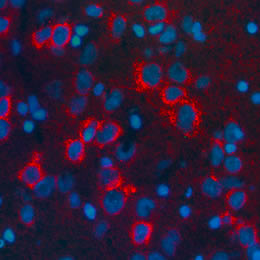beta-Lipotropin - Cat #:MV1004
| Product Description |
Rabbit polyclonal antibody to N-terminal portion of human beta Lipotropin conjugated to thyroglobulin |
 Immunohistochemical staining of beta-Lipotropin in mouse brain. 4% paraformaldehyde fixed rat brain 10 μm thick cryostat sections were incubated with rabbit polyclonal antibody to beta-Lipotropin at 10 μg/mL overnight at 4°C followed by incubation with Donkey anti-rabbit Rhodamine Red conjugated secondary antibodies at 1:200. Tissue was counterstained with DAPI (blue color) to visualize cell nuclei. Immunohistochemical staining of beta-Lipotropin in mouse brain. 4% paraformaldehyde fixed rat brain 10 μm thick cryostat sections were incubated with rabbit polyclonal antibody to beta-Lipotropin at 10 μg/mL overnight at 4°C followed by incubation with Donkey anti-rabbit Rhodamine Red conjugated secondary antibodies at 1:200. Tissue was counterstained with DAPI (blue color) to visualize cell nuclei. |
| Formulation |
Lyophilized from 10 mM PBS. |
| Purification |
Whole IgG |
| Host Species |
Rabbit |
| Unit Size: |
50 µg |
| Immunogen |
human beta Lipotropin conjugated to thyroglobulin. |
| Antigen Location (aa): |
179 - 267 |
| Alternative Names |
beta-LPH |
| Accession Number: |
P01189 |
| Accession Name: |
COLI_HUMAN |
| Accession URL: |
http://www.uniprot.org/uniprot/P01189 |
| Function: |
beta-Lipotropin is a 90-amino acid polypeptide that is the carboxy-terminal fragment of POMC. It stimulates melanocytes to produce melanin, and can also be cleaved into smaller peptides including opioid peptides: gamma-lipotropin, alpha-MSH, beta-MSH, gamma-MSH, alpha-endorphin, beta-endorphin, gamma-endorphin and met-enkephalin. |
| Applications: |
Recommended for Immunohistochemistry (IHC) and Cytochemistry (ICC). |
| Working Dilution for Immunofluorescence (ICC): |
5 – 15 µg/ml |
| Working Dilution for Immunohistochemistry (IHC): |
5 – 10 µg/ml |
| IHC Positive control: |
Brain |
| Specificity: |
Confirmed by RIA against the synthetic peptide. |
| Cross-reactivity: |
Human; mouse; rat. Beta-endorphin is a highly conserved molecule, so cross-reactivity with other species is expected. Cross-reactivity with other opioid peptides is as follows: with Met-enkephalin 0.03%; with Leu-enkephalin 0.02%; with beta-lipotropin 0.34%. |
| Reconstitution: |
Reconstitute in 0.05 ml of PBS (pH 7.4) to achieve an antibody concentration of 1000 µg/ml. Centrifuge to remove any insoluble material. |
| Storage / Stability: |
At least 12 months after purchase at 2 - 4°C. After reconstitution, aliquot and store at -20°C for a higher stability and at 4°C with an appropriate antibacterial agent. Avoid freeze-thaw cycles. |
References:
- Stengaard-Pedersen K, Larsson LI. (1981) Histochemistry, 73(1):89-114. PMID: 6274830.
- Williams RG, Dockray GJ. (1983) Neuroscience, 9(3):563-586. PMID: 6312371.
- Wang BL, Larsson LI. (1985) Histochemistry, 83(1):47-56. PMID: 2412988.
- Moore MR, Black PM. (1991) Neurosurgical Review, 14(2):97-110. PMID: 1870724.
- Höftberger R, Kunze M, Voigtländer T, et al., Endocrinology. 2010 Oct;151(10):4801-10. PMID: 20810565.
- Kuhla B, Albrecht D, Bruckmaier R, Viergutz T, Nürnberg G, Metges CC. Proteomics. 2010 Oct 14. 21105009.
|
 Immunohistochemical staining of beta-Lipotropin in mouse brain. 4% paraformaldehyde fixed rat brain 10 μm thick cryostat sections were incubated with rabbit polyclonal antibody to beta-Lipotropin at 10 μg/mL overnight at 4°C followed by incubation with Donkey anti-rabbit Rhodamine Red conjugated secondary antibodies at 1:200. Tissue was counterstained with DAPI (blue color) to visualize cell nuclei.
Immunohistochemical staining of beta-Lipotropin in mouse brain. 4% paraformaldehyde fixed rat brain 10 μm thick cryostat sections were incubated with rabbit polyclonal antibody to beta-Lipotropin at 10 μg/mL overnight at 4°C followed by incubation with Donkey anti-rabbit Rhodamine Red conjugated secondary antibodies at 1:200. Tissue was counterstained with DAPI (blue color) to visualize cell nuclei.